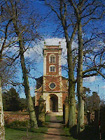




The Early Days
|
The science of microbiology started with the invention of the microscope. The English scientist Robert Hooke is credited with being the first person to use a microscope for academic study. That was in the early 1660's. In 1665 Hooke published his landmark book Micrographia, which described the microscopic world for the first time. Hooke studied plant sections, in particular cork and he drew what he saw, which was a matrix of tiny cylindrical-like structures he called cells. Later researchers saw such structures in all types of living organism and Hooke's naming remained. Today it is considered to be a foundation stone in the understanding of microbiology. (Left) A sketch of Hooke's microscope. (Right) No images of Hooke survive. Willen Church in Buckinghamshire, England, was designed by Robert Hooke who also discovered Hooke's Law and the Great Red Spot on the planet Jupiter.
|
||||
| Meanwhile in continental Europe others, such as Marcello Malpighi in Italy and Antonie van Leeuwenhoek in the Netherlands, were using microscopes to look at animal and plant tissue. Van Leeuwenhoek examined a drop of rainwater and noticed it contained tiny creatures he called "animalicules" or little eels. These were in fact bacteria and so van Leeuwenhoek became the first person to study bacteria. | |
 Some
form of microbiological treatment was practiced by many people, throughout
the two hundred year period after Hooke and van Leeuwenhoek, but this
was with very little understanding of the microbial processes involved.
Primitive
forms of smallpox inoculation developed in Turkey in the seventeenth
century were brought to England around 1720. This involved creating
reasonably large open wounds in the arm with a knife and pasting in
serum taken from the pusy sores of victims. It was effective
- sometimes - and even some members of the royal family underwent
the procedures. Elsewhere in England, particularly at
Yetminster
in Dorset, cowherds and milkmaids had noticed the immunizing effects
of cowpox in apparently preventing smallpox,
and they too practiced a form of open-wound inoculation on local people. Some
form of microbiological treatment was practiced by many people, throughout
the two hundred year period after Hooke and van Leeuwenhoek, but this
was with very little understanding of the microbial processes involved.
Primitive
forms of smallpox inoculation developed in Turkey in the seventeenth
century were brought to England around 1720. This involved creating
reasonably large open wounds in the arm with a knife and pasting in
serum taken from the pusy sores of victims. It was effective
- sometimes - and even some members of the royal family underwent
the procedures. Elsewhere in England, particularly at
Yetminster
in Dorset, cowherds and milkmaids had noticed the immunizing effects
of cowpox in apparently preventing smallpox,
and they too practiced a form of open-wound inoculation on local people.
|

|
However, the credit for the invention of inoculation now goes to Edward Jenner who in 1796 injected cowhand James Phipps with cowpox. Jenner gets the credit because he carried out his work using accepted scientific method and wrote it up afterwards, though the ethics of deliberately injecting the experimental subject with smallpox some six weeks later is questionable! Fortunately, the boy did not develop smallpox and Jenner became rich and famous as a result. It was from this risky beginning that the science of immunization developed. Smallpox (Variola virus) was declared officially eliminated in 1979 - the only microbial disease ever deliberately eradicated. While many scientists of the eighteenth and nineteenth century studied plant and animal structures under the microscope, the real science of microbiology only began in the latter half of the nineteenth century, when high- magnification microscopes of good optical quality became more widely available. The most notable person was Ferdinand J Cohn who in 1875 effectively founded the science of bacteriology (a branch of microbiology which studies bacteria). His main contribution was the classification of bacteria, and he coined the term Bacillus. |
|
Louis Pasteur was probably the greatest biologist of the nineteenth century. He developed the germ theory of disease, which was a significant breakthrough in medicine that ultimately improved the health of everyone on the planet. He was also able to prove that life itself did not "spontaneously come into being" through a series of experiments using a sterilized flask. He successfully showed that life can only be generated from existing life, thus closing debate - so he thought - that had obsessed science and theology for a long time (though current ideas and successes in the field of "creating life" has re-opened the issue). Pasteur also showed that fermentation - a process used in baking and brewing - was caused by microorganisms. As a result of this work he went on to develop the process for sterilizing milk and this was named after him - pasteurization. He is also credited with the development of vaccines, most notably for rabies and anthrax. In addition, he identified and eliminated disease in silkworms. He was also interested in the idea of panspermia that was promoted by Lord Kelvin in 1871, and went on to examine the Orgeuil meteorite for signs of life. |
|
|
Since the time of these pioneers, almost every year major breakthroughs in microbiological science have been made. Both individuals and, more recently, teams of people have contributed to our understanding of the science. They have taken it from being primarily a branch of medicine to become a means of food production, a branch of study for engineers, an integral part of understanding ecology and the environment, a foundation-stone of the chemical and biochemical industries, and of tremendous interest to those engaged in all aspects of space research and exploration. Continue - Some Famous Microbiologists Go to - What is Microbiology? |
![]()
History
of Medicine: Smallpox
Highlights
in the history of Microbiology
History
of Immunology
Go
to
Home
| Space Station
| Mars | Rainforest
© 1999 Satellite Events Enterprises Inc.


